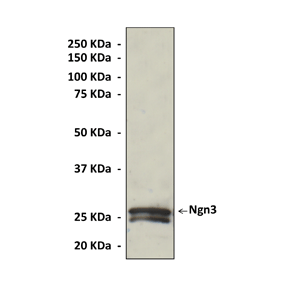Product Sheet CY1122
Description
BACKGROUND Neurogenin-3 (Ngn3, Neurog3) belongs to the basic helix-loop-helix (bHLH) class of transcription factors and functions primarily as an activator of gene transcription in endocrine progenitor cells. It is expressed in a small percentage of cells within the developing pancreas, consisting of endocrine progenitor cells, and functions to directly enhance the expression of the lineage-committed transcription factors required for the differentiation of the endocrine progenitor cells into each of the endocrine cell subtypes. For example, Ngn3 binds directly to the promoters of the beta-cell specific transcription factors b2/NeuroD and Pax4 to promote the differentiation of progenitor cells into the beta cell lineage. Ngn3 expression is extinguished coincident with the expression of the endocrine hormones that define the endocrine lineages, for example the insulin expression in beta cells. Either disrupted or forced expression of Ngn3 early in mouse pancreas development abrogates the formation of islets. The successive waves of Ngn3 expression that occur during the primary and secondary transitions of endocrine cell development temporally determine the four distinct endocrine cell lineages, α, β, PP, and δ cells that express glucagon, insulin, pancreatic polypeptide, and somatostatin, respectively. During islet regeneration after injury of the adult mouse pancreas, such as by duct ligation or streptozotocin, Ngn3 is activated in duct-associated stem/progenitor cells that transform into alpha and/or beta cells.1 Additionally, because Ngn3 has not been detected in differentiated islet cells, its expression in the adult pancreas is proposed as a marker for putative endocrine progenitors. However, it was shown that differentiated hormone+ islet cells continue to express Ngn3, and that Ngn3 is important for both islet cell production and function.2 Moreover, Ngn3 is sufficient for in vivo transdetermination of hepatic progenitor cells into islet-like cells but not transdifferentiation of hepatocytes. It was further shown that gene therapy with Ngn3 and betacellulin corrects the underlying dysregulated glucose and lipid metabolism in insulin-deficient diabetic mice by inducing neo-islets in the liver that are similar to pancreatic islets in structure and gene expression profile.3 The important role of Ngn3 as a master regulator of endocrine pancreas development directs attention to finding therapeutic approaches to enhance Ngn3 expression in diabetes as a means to increase beta cell mass and functions.
The mammalian ngn subfamily currently has three members; all are expressed in the developing CNS and PNS. Ngn1 and ngn2 are well studied in neural development. However, reports on ngn3\'s role in the development of the nervous system are limited. In rodents, ngn3 is expressed in glial precursors in the developing spinal cord and regulates glial differentiation. It was shown that ngn3 regulates retinal neurogenesis at an early point of an intricate transcriptional network that links diverse cell types in the developing retina.4
The mammalian ngn subfamily currently has three members; all are expressed in the developing CNS and PNS. Ngn1 and ngn2 are well studied in neural development. However, reports on ngn3\'s role in the development of the nervous system are limited. In rodents, ngn3 is expressed in glial precursors in the developing spinal cord and regulates glial differentiation. It was shown that ngn3 regulates retinal neurogenesis at an early point of an intricate transcriptional network that links diverse cell types in the developing retina.4
REFERENCES
1. Rukstalis, J.M. & Habener, J.F.: Islets 1:177-84, 2009
2. Wang, S. et al: Proc. Natl. Acad. Sci. USA 106:9715-20, 2009
3. Yechoor,V. et al: Dev. Cell 16:358–73, 2009
4. Ma, W. et al: Mol. Cell. Neurosci. 40:187–98, 2009)
2. Wang, S. et al: Proc. Natl. Acad. Sci. USA 106:9715-20, 2009
3. Yechoor,V. et al: Dev. Cell 16:358–73, 2009
4. Ma, W. et al: Mol. Cell. Neurosci. 40:187–98, 2009)
Products are for resaearch use only. They are not intended for human, animal, or diagnostic applications.
Details
Cat.No.: | CY1122 |
Antigen: | Short peptide from human Ngn3 sequence |
Isotype: | Rabbit IgG |
Species & predicted species cross- reactivity ( ): | Human, Mouse, Rat |
Applications & Suggested starting dilutions:* | WB 1:1000 IP n/d IHC n/d ICC n/d FACS n/d |
Predicted Molecular Weight of protein: | 27 kDa |
Specificity/Sensitivity: | Detects endogenous Ngn3 proteins without cross-reactivity with other family members. |
Storage: | Store at -20°C, 4°C for frequent use. Avoid repeated freeze-thaw cycles. |
*Optimal working dilutions must be determined by end user.
Products
| Product | Size | CAT.# | Price | Quantity |
|---|---|---|---|---|
| Rabbit Neurogenin-3 Antibody: Rabbit Neurogenin-3 Antibody | Size: 100 ul | CAT.#: CY1122 | Price: $384.00 |

